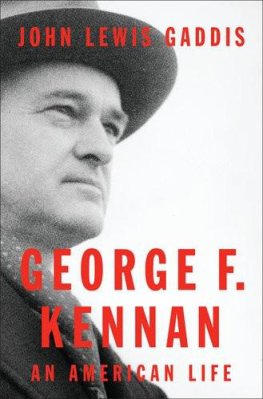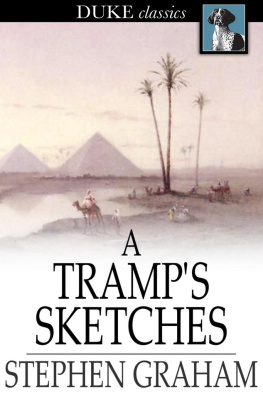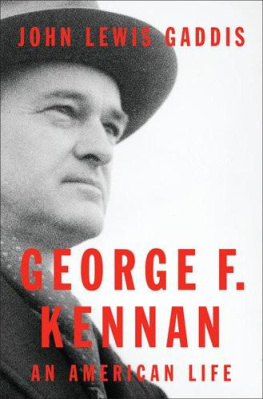
SKETCHES
FORM A
L  I
I  F
F  E
E
George F. Kennan

W.W. Norton & Company
New York London
PREFACE TO THE NORTON PAPERBACK EDITION
I am naturally gratified, and pleasantly surprised, to learn that there is to be another edition of my Sketches. The various items of which that book is composed are a curious collection of documents to find themselves side by side under a single cover. There was no uniformity in subject matter or circumstances to bring them all together. They were written almost exclusively as entries in travel diaries composed at various times and in various places over a span of some sixty years. What they convey are either glimpses of passing phenomena detached from the identity of the writer, or descriptions of certain of his experiences, as he felt and reacted to them at the time. There are no personal or intimate descriptions of other persons; and if the personal qualities of the author, positive or negative, shine through at many points, as they were bound to do, they were only incidental to the subject in question.
It is interesting for the author, seeing these papers again after so many years, to reflect that if there is, after all, any unity among them, it lies in such literary quality as they can be said to have had. I had, before their first published appearance, written some seventeen other books, and two or three others were to follow. These were primarily works of diplomatic history, memoirs, or commentaries on public issues of the time. None were conceived primarily as literary documents, although there may have slipped through here and there pages to which literary quality might or might not, depending on the readers taste, be plausibly attributed. But the Sketches were the only one of my books where, even if not intended for publication, efforts were made to give consideration at many points to literary effect.
The readers of this volume will stand farther away in time from the subject matter of the papers than did those who read the earlier edition. It is the authors hope that such literary touches as various of the papers received will help to give them reality and meaning for those who read them not only in a later decade but even (it is hard to realize) in another century.
George F. Kennan
PREFACE
As the stage for any and all adventures there suffices a single human heart.
ALFONS PAQUET
T his book might be described as a collection of diary excerpts, illustrating one persons reactions, over a long span of time, to a variety of scenes, places, and landscapes. When the suggestion for their publication came, as it did, from a good friend, I confessed myself unable to form any judgment as to what impression such papers might make upon a wider public or whether this would be useful enough to warrant their publication. For this they were too close to metoo close to a life advancing age had taught me to view with neither excessive pride nor excessive remorse. It was too late now for such exercises in introspection. I had done what I could. I was aware of my faults and mistakes. They could not now be corrected. And I knew the pitfalls of self-satisfaction. I tried, therefore, to avoid judgments on myself, my doings, my attempts to understand the life of my time. All that would have to be left, I thought, to a deity heldif only by faithto be benevolent. The reader would have to arrive at his own conclusions as to whether the reactions to certain aspects of the external environment, as assembled in this volume, could help them to understand, as the younger man who wrote these pieces had tried to do, the pageant of his time. But it occurred to me that if there were then no claims, no promises, no apologies I could advance on behalf of the bits of prose assembled here, there were at least a few explanations I might offer as to how and why they came to be written and for what they were intended.
There have been three kinds of reactions that I, like so many other people, have from time to time felt the impulse to put to paper. There were the intimate ones; there were the intellectual ones; and there was a third category, for which I can now find no brief generic designation, but into which the offerings contained in this book may be considered as falling.
The intimate reactions were those that concerned the more intense aspects of involvement with the self or with others. These I have always found it difficult to commit to paperat least for the eyes of others. Perhaps I was too much of a coward: too conscious of the fragility of the individuals innermost identity; too respectful of that identitys need for, and right to, privacy; too accustomed to view this as a privileged inner chamber, cluttered with fragile objects, into which the clumsy finger of the outsider could not be thrust without creating breakage and havoc. I preferred, I thought, to leave all this to the novelist or the poet, whose greater brutality, in the one case, and more natural use of the allusive rather than the explicit, in the other, permitted a bolder penetration into these dangerous premises.
The intellectual reactions (thought, history, social and political analysis, scholarship in general) have been the ones that strove hardest for depersonalization and sought the greatest possible distance from subjectivity (from which, of course, there is never, and should not be, any total emancipation). Of this sort of literature I have written a great deal; and this, in a number of incarnations: as a reporting officer in the American foreign service, as an historian, as a commentator on international problems. This writing has of course constituted the backbone of my professional life; and I have had much satisfaction from it. I view it (when honestly pursued) as a respectable, useful, relatively innocent and inoffensive employment, capable (with some luck) of earning for its devotee a living, but with possibilities for usefulness to others as well in the measure of its honesty, seriousness, and persuasiveness.
The third category of writing, as mentioned above, operates in the no-mans-land between these two others, borrowing a bit from both, contributing a bit to both. As purposed in this book, it might be described as the effort to depict isolated bits of reality, casually observed, in a manner that, while as faithful as possible to the features of the scene observed, also reveals something of its inner meaning. Something of this sort is, of course, essentially what takes place in the more naturalistic of the visual arts, where, again, the object is not one of the artists own creation but is rather an existing external reality, in the depiction and critical interpretation of which the artist expresses things he could never have expressed in direct assertion.
The inspiration for this kind of writing came from a book I happened to stumble upon at a time when I was quite young and living in Europein 1928, I think it was. It was a volume of travelogues from the pen of the talented itinerant correspondent of the Frankfurter Zeitung of that day, Alfons Paquet, a highly cultured European cosmopolitan of his time, half-French, half-German (as I seem to recall), and a fine writer. scenes observed in remote places, and hence with the freshness of first impression, there was normally and quite literally more than met the eyea deeper reality seldom visible on the surface but there to be sensed, if not seen, with the requisite intuition and effort.
Next page









 I
I 